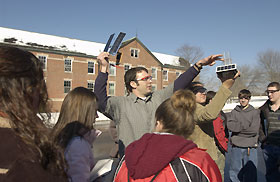For more archives, go to the Advance Archive/Search Page.
Fuel Cell Center Opens Door
To High School Students
Two busloads of ninth-graders arrived at the Connecticut Global Fuel Cell Center one winter morning. Would there be a couple of future scientists among them?

|
|
Jesse Hayes, a research assistant with the Fuel Cell Center, shows ninth-graders from Foran High School in Milford a solar hydrogen
system. Their visit to UConn was part of the center's efforts to attract students to science.
Photo by Dollie Harvey
|
The center, usually a hub of research activity, opened four of its extensive laboratories for several hours to host students from J.A. Foran High School in Milford.
One of the center's key goals is to acquaint students of all ages with fuel cell research and technology, with the hope of inspiring some to become scientists, and instilling in others an understanding of fuel cells as a renewable energy source.
"Opening up a research facility to young people is a perfect opportunity for them to see people as scientists and people who have a passion for research," says Tricia Bergman, the center's associate director.
Although fuel cell technology is a complex topic, Bergman says, kids can connect with the subject because of their experience with cell phones and other electronic devices, all of which are battery powered and require recharging on a regular basis.
With this in mind, the research team prepared several demonstrations to pique the interest of their first high school visitors - more than 60 students from George Benedetti's science classes.
A licensed professional engineer, Benedetti has spent the past four years at J.A. Foran High School trying to interest his students in the sciences. One day, a student's question about fuel cells sparked an idea.
Benedetti realized he could use the science behind fuel cells - the chemical reaction between hydrogen and oxygen that produces water and energy - to teach his students about exothermic chemical reactions. He approached the center for help and received an enthusiastic reception.
"I turned to the world's best facility for help," says Benedetti, a UConn alum. "I have some dedicated kids, and the Connecticut Global Fuel Cell Center has the resources."
Trent Molter, one of the center's research scientists, kicked off the visit by presenting a lesson on the basics of energy, its sources, and uses. Before the students broke into four smaller groups for the hands-on demonstrations, Molter issued a challenge. By the end of the visit, the group that could answer his question would receive a reward. Could they figure out how many miles a car powered by a fuel cell could travel on one liter of water?
In one lab, students were treated to a demonstration of a portable fuel cell being developed for the U.S. Army. In another, students received a demonstration on extruding tubes for solid oxide fuel cells. In the third lab, students learned how member electrode assemblies were produced. The session included a screen printing demonstration. In the final lab, Jesse Hayes, a research assistant with the center, entertained the students with a remote controlled car and a stereo powered by a fuel cell.
Hayes's demonstration meant the most to ninth-grader Laura Lennon, a student who said she likes learning about how things operate.
"Fuel cells are a hard topic to catch on to," she said, but she learned enough to wonder why they are not yet a popular renewable energy resource.
Kayla Naposki's favorite subject is math, and the economics of fuel cells seemed to be what stayed on her mind. Although she was intrigued by how fuel cells are made and what they can be used for, she was most interested to learn that fuel cells will only begin to "help the economy when the prices come down and they become more affordable."
Although only time will tell whether some of the students take up careers in the sciences, for Benedetti, just seeing his students at a major research facility was thrilling.
"Some of these kids met a real live scientist for the first time in their lives. They saw that science can be fun and creative, and that both men and women can be scientists," he said. "This is stuff they can't get from a book."
At the end of the visit, each class was asked for their solution to Molter's problem. Though no one came up with the exact answer (5 miles), the group with the closest estimate (3.8 miles) received a small reward.
Before the students had filed out of the center, Benedetti had already made a commitment to return next
fall with a new group of students. In the meantime, the center is preparing for visits from schools in Danbury and Windsor.

